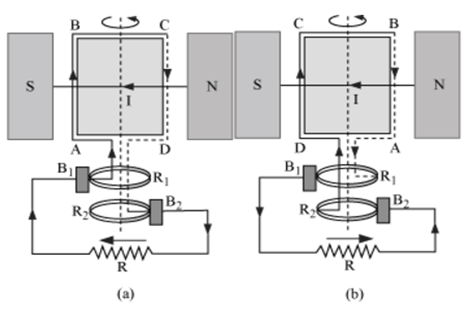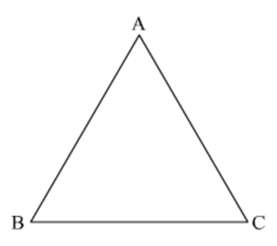 Long Answer Type
Long Answer TypeDescribe the working principle of a moving coil galvanometer.
Why is it necessary to use
(i) a radial magnetic field and
(ii) a cylindrical soft iron core in a galvanometer?
Write the expression for the current sensitivity of the galvanometer.
Can a galvanometer as such be used for measuring the current? Explain.
(a) Define the term 'self-inductance' and write its S.I. unit.
(b) Obtain the expression for the mutual inductance of two long co-axial solenoids S1 and S2 wound one over the other, each of length L and radii r1 and r2 and n1 and n2 number of turns per unit length when a current I is set up in the outer solenoid S2.
Construction

Main parts of an ac generator:
Armature − Rectangular coil ABCD
Filed Magnets − Two pole pieces of a strong electromagnet
Slip Rings − The ends of coil ABCD are connected to two hollow metallic rings R1 and R2.
Brushes − B1 and B2 are two flexible metal plates or carbon rods. They are fixed and are kept in tight contact with R1 and R2 respectively.
Theory and Working − As the armature coil is rotated in the magnetic field, angle θ between the field and normal to the coil changes continuously. Therefore, magnetic flux linked with the coil changes. An emf is induced in the coil. According to Fleming’s right-hand rule, current induced in AB is from A to B and it is from C to D in CD. In the external circuit, current flows from B2 to B1.
To calculate the magnitude of emf induced:
Suppose
A → Area of each turn of the coil
N → Number of turns in the coil
 → Strength of magnetic field
→ Strength of magnetic field
θ → Angle which normal to the coil makes with ![]() at any instant t
at any instant t

∴ Magnetic flux linked with the coil in this position:
 = NBA cosθ= NBA cosωt …(i)
= NBA cosθ= NBA cosωt …(i)
Where, ‘ω’ is angular velocity of the coil
As the coil rotates, angle θchanges. Therefore, magnetic flux Φ linked with the coil changes and hence, an emf is induced in the coil. At this instant t, if e is the emf induced in the coil, then

(a) Draw a labelled diagram of a step-up transformer. Obtain the ratio of secondary to primary voltage in terms of number of turn and currents in the two coils.
(b) A power transmission line feeds input power at 2200 V to a step-down transformer with its primary windings having 300 turns. Find the number of turns in the secondary to get the power output at 220 V.
Derive an expression for drift velocity of electrons in a conductor. Hence deduce Ohm's law.
The current is drawn from a cell of emf E and internal resistance r connected to the network of resistors each of resistance r as shown in the figure. Obtain the expression for (i) the current draw from the cell and (ii) the power consumed in the network.
(i) A ray of light incident on face AB of an equilateral glass prism shows the minimum deviation of 30°. Calculate the speed of light through the prism.

(ii) Find the angle of incidence at face AB so that the emergent ray grazes along the face AC.
